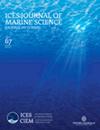Hydro-acoustic classification and abundance estimation of mesopelagic fish in deep scattering layers (DSL) of the Indian Ocean
IF 3.4
2区 农林科学
Q1 FISHERIES
引用次数: 0
Abstract
Deep scattering layers (DSL) in oligotrophic systems are typically comprised of a variety of coexisting organisms, including fish, zooplankton, jellyfish, and squid, and hence there is uncertainty about the proportion of the acoustic backscatter in these layers that can be attributed to mesopelagic fish. Here, acoustic targets were classified using a multi-frequency acoustic classification algorithm based on data collected in the Indian Ocean at 18, 38, 70, and 120 kHz during three acoustic surveys in 2018. Frequency-dependent backscattering strength information (∆Sv) was extracted from acoustic data that coincided with trawl hauls dominated by mesopelagic fish. Five ∆Sv frequency pairs were used to separate the acoustic backscattering into three broad scattering categories, i.e. mesopelagic fish, crustacean-like/tunicates, and squids/others. Results indicated that the DSL is highly diverse and dominated by mesopelagic fish, with average densities at a regional scale ranging from 12.0 (±10.9) to 26.0 (±21.7) g m−2, and proportions of the acoustic backscatter attributed to mesopelagic fish ranging from 0.5 to 0.7. These estimates are generally lower than previously estimated for other regions of the Indian Ocean. The situation may well be similar elsewhere, particularly in oligotrophic systems, with potential ramifications for global mesopelagic fish biomass estimates.印度洋深散射层(DSL)中层鱼类的水声分类和丰度估算
寡营养系统中的深散射层(DSL)通常由多种共存生物组成,包括鱼类、浮游动物、水母和鱿鱼,因此这些层中可归因于中上层鱼类的声学反向散射比例存在不确定性。在此,根据 2018 年三次声学调查期间在印度洋收集的 18、38、70 和 120 千赫数据,使用多频率声学分类算法对声学目标进行了分类。与频率相关的反向散射强度信息(ΔSv)是从与中上层鱼类为主的拖网拖网吻合的声学数据中提取的。利用五个 ∆Sv 频率对将声学反向散射分为三大散射类别,即中上层鱼类、甲壳类/独角鲸和鱿鱼/其他。结果表明,DSL 种类繁多,以中深层鱼类为主,区域范围内的平均密度为 12.0 (±10.9) 至 26.0 (±21.7) g m-2,中深层鱼类在声学反向散射中所占比例为 0.5 至 0.7。这些估计值普遍低于以前对印度洋其他地区的估计值。其他地区的情况也很可能类似,特别是在寡营养系统中,这对全球中上层鱼类生物量的估算具有潜在影响。
本文章由计算机程序翻译,如有差异,请以英文原文为准。
求助全文
约1分钟内获得全文
求助全文
来源期刊

ICES Journal of Marine Science
农林科学-海洋学
CiteScore
6.60
自引率
12.10%
发文量
207
审稿时长
6-16 weeks
期刊介绍:
The ICES Journal of Marine Science publishes original articles, opinion essays (“Food for Thought”), visions for the future (“Quo Vadimus”), and critical reviews that contribute to our scientific understanding of marine systems and the impact of human activities on them. The Journal also serves as a foundation for scientific advice across the broad spectrum of management and conservation issues related to the marine environment. Oceanography (e.g. productivity-determining processes), marine habitats, living resources, and related topics constitute the key elements of papers considered for publication. This includes economic, social, and public administration studies to the extent that they are directly related to management of the seas and are of general interest to marine scientists. Integrated studies that bridge gaps between traditional disciplines are particularly welcome.
 求助内容:
求助内容: 应助结果提醒方式:
应助结果提醒方式:


